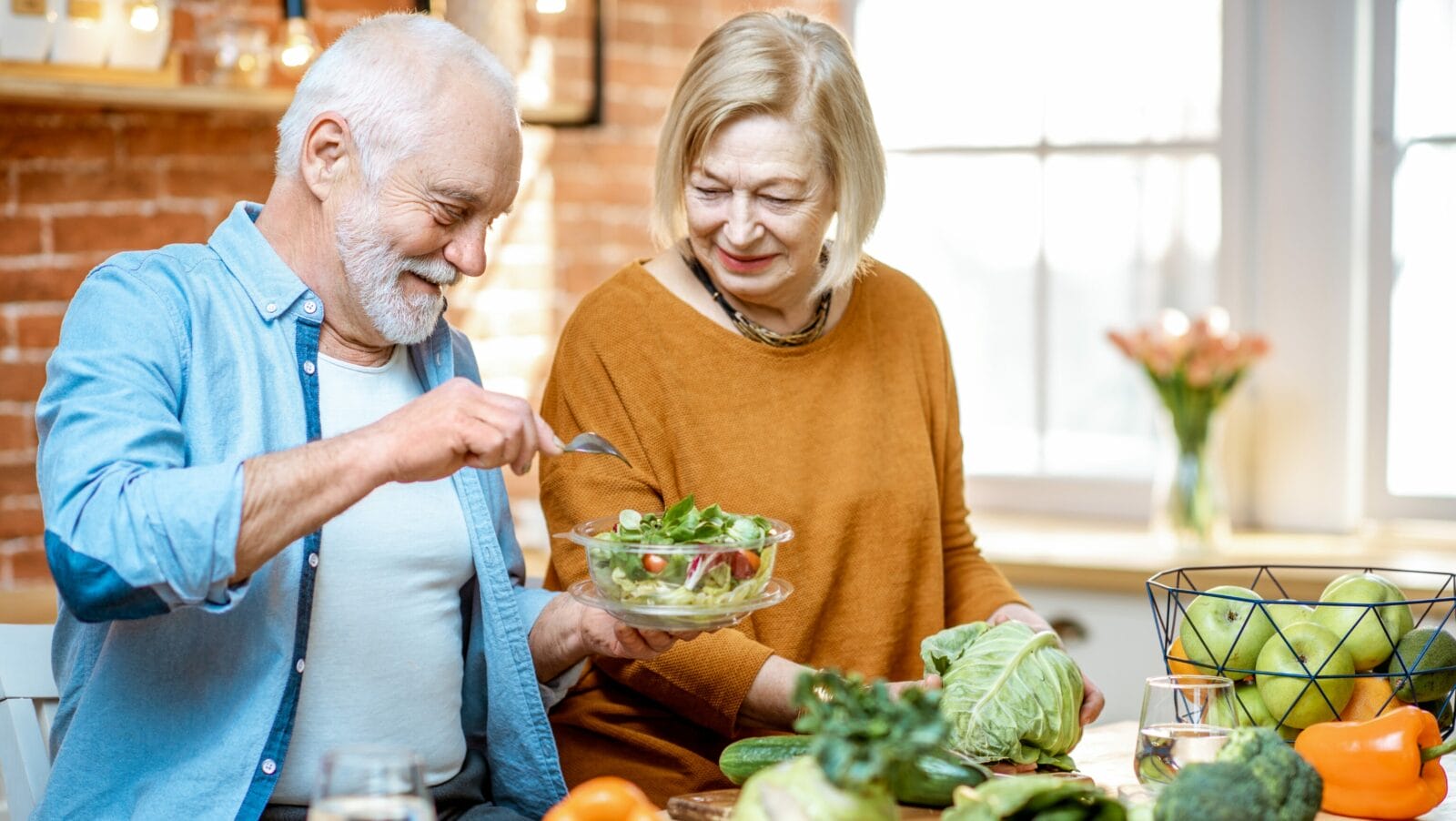Nutrition is one of the most important aspects of your health and overall well-being. It’s even more important for seniors, who may struggle with chronic health conditions and weakened immune systems. Dietary needs also change after the age of 60. It can be hard to keep up with new research and understand what you need to do to live your best life as a senior. We’ll give you practical, easy-to-follow tips that make great nutrition easy in this guide to healthy eating for seniors.
Understanding Nutritional Needs After 60
Did you know that your dietary needs change after the age of 60? As you get older, your metabolism slows down, which affects how the body processes food. This means you need more nutrients in your diet, such as protein, potassium, vitamin B12, calcium, vitamin D, and fiber (1). Certain medications can also decrease how much vitamin B12 and iron that you get from food. Seniors actually need more protein than children or younger adults. Your body becomes less effective at processing protein as you age. Eating more protein also helps to prevent muscle loss and degeneration.
It’s important to pay attention to your diet, because your nutrition needs change as you get older. You might need to make some changes to your lifestyle and meals to help you maintain your health and well-being. Healthy eating can also help prevent and even treat chronic conditions like diabetes, heart disease, and dementia. Always consult your doctor before making any changes to your diet or lifestyle.
Hydration is also vitally important to your health and diet. Seniors are at a higher risk for dehydration. As you age, it’s normal to experience a decreased sense of thirst. Dehydration is therefore a serious risk for senior citizens.
Important Nutrients and Where to Find Them
So, what are the most important nutrients seniors need, and where can you find them?
The key nutrients most seniors need include:
- Protein
- Dietary fiber
- Calcium
- Vitamin D
- Vitamin B12
- Potassium
Animal products like meat, cheese, milk, and other dairy products provide a great source of protein. You can also get protein from plant sources, like beans, lentils, soy, and peas. Other good ways to get protein include whole grains like quinoa and oatmeal.
One thing to remember: aside from quinoa and soy products, plant sources of protein are not complete proteins. This means they don’t contain all 9 essential amino acids. However, you can get all of the amino acids by eating lots of different types of plant protein throughout the day. All protein from animal products, like meat and dairy, are complete proteins.
Dairy products are a good way to get calcium and vitamin D, as well as protein. Most of the milk that you buy is enriched with vitamin D. Some vegetables, like kale and broccoli, have calcium as well.
When it comes to fiber, whole grains are again important. Oatmeal, popcorn, and whole wheat bread is a good place to start. Fruits and veggies usually contain a good amount of fiber too. Raspberries, pears, apples, bananas, oranges, and strawberries are all great choices. These also contain important vitamins. Bananas are full of potassium, as are potatoes, low-fat milk, and avocados. Beans have a good amount of fiber as well as protein.
You can also get vitamin B12 from many of these foods, like poultry, meat, fish, and dairy products.
Managing Common Health Conditions with Diet
Eating a balanced diet that includes these essential nutrients can help you manage many of the health conditions seniors face. For example, extra protein and fiber in your diet can help keep your blood sugar stable if you have diabetes. Increased calcium could prevent or help treat osteoporosis. Lower-fat diets with increased fiber and protein and lots of whole foods might also help prevent heart disease. If you have high blood pressure, a lower-sodium diet may help.
Consult your doctor before you make any changes to your diet. This is especially important if you have diabetes, heart disease, or any other medical conditions. Your doctor can also provide personalized nutrition advice and guidance.
Overcoming Challenges to Healthy Eating
Healthy eating and nutrition is a challenge for many seniors. You might experience reduced appetite, difficulty chewing, or limited mobility as you get older. It’s also hard to be motivated to eat healthy sometimes. It can seem more expensive or time consuming to eat healthy. It might feel like just too much work to bother with!
However, a nutritious diet that helps prevent and treat health conditions will always pay off in the long run. You will save money on doctor visits, medications, and other healthcare costs. You’ll also lead a longer, healthier, and happier life! Healthy eating doesn’t have to be hard. Consider eating more mindfully and paying attention to the flavor and texture of the foods you eat, for a more satisfying eating experience. Pay attention to the portions you serve yourself.
Make eating nutritious foods easy. Try meal planning so you don’t have to decide what to make for every meal on the spot. Choose foods you enjoy, and take advantage of conveniences like prepackaged salad and fruit salad. Food or grocery delivery services might make your life easier, too.
If you’re in need of easy and healthy recipes, check out this post for some great options!
For the easiest way to eat healthy as a senior, consider senior living. Senior living communities almost always have chefs and dietitians that prepare nutritionally balanced foods at every meal! It’s a great way to take all the challenges out of healthy eating.




